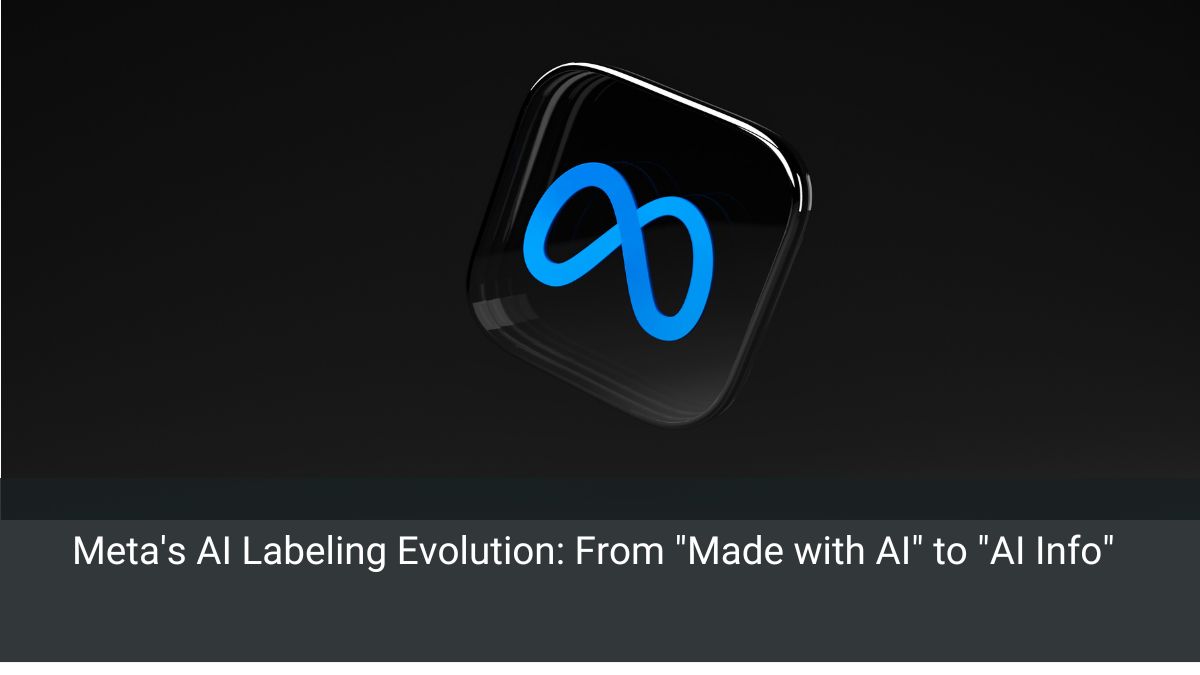Ad Tech
Meta’s AI Labeling Evolution: From “Made with AI” to “AI Info”

In the ever-evolving landscape of digital media, the line between human-created content and AI-assisted work continues to blur. Meta, the tech giant behind Facebook and Instagram, recently found itself at the center of this debate. Their attempt to bring transparency to AI-generated content has sparked a conversation about the nuances of content creation in the digital age.
The Initial Approach: “Made with AI”
A Well-Intentioned Start
In May, Meta rolled out a new feature across its platforms: a “Made with AI” label for photos. The intention was clear – to provide users with transparency about the origin of the content they were viewing. As someone who regularly scrolls through social media, I initially appreciated this effort to distinguish between AI-generated and human-created content.
Unintended Consequences
However, the road to digital transparency is often paved with unforeseen challenges. Photographers, the very individuals whose work Meta aimed to protect, found themselves at the center of an unexpected controversy. Many complained that their authentic photos, touched up with basic editing tools, were being tagged as “Made with AI.”
This situation reminded me of a recent experience where I posted a sunset photo I had taken. To my surprise, a friend commented, asking if it was AI-generated. The incident highlighted how our perception of reality in the digital realm has become increasingly complex.
The Pivot: Introducing “AI Info”
Listening to User Feedback
In response to the outcry and confusion, Meta has decided to rebrand its AI label. The new tag, “AI Info,” represents a more nuanced approach to identifying AI involvement in content creation.
A Broader Perspective
Meta’s spokesperson, Kate McLaughlin, explained the rationale behind the change: “‘AI Info’ can encompass content that was made and/or modified with AI so the hope is that this is more in line with people’s expectations, while we work with companies across the industry to improve the process.”
This shift acknowledges the spectrum of AI involvement in content creation – from minor retouching to full generation. It’s a recognition that AI’s role in our creative processes is not binary but exists on a continuum.
The Technical Underpinnings
Metadata Matters
Despite the label change, Meta’s underlying technology for detecting AI use remains unchanged. The company relies on technical metadata standards such as C2PA and IPTC, which include information about the use of AI tools in image creation or modification.
The Adobe Conundrum
This approach means that photos edited with AI-powered tools like Adobe’s Generative AI Fill might still receive the “AI Info” tag. It’s a reminder of how deeply AI has penetrated even the most basic editing processes. As someone who occasionally uses such tools for hobby photography, I’ve often wondered about the implications of these “invisible” AI assistants.
The Broader Implications
A Step Towards Transparency
Meta’s labeling initiative, despite its challenges, represents a significant step towards transparency in the digital content landscape. In an era where deepfakes and AI-generated content are becoming increasingly sophisticated, such efforts are crucial for maintaining trust online.
The Challenge of Detection
However, the new tag doesn’t solve all problems. Completely AI-generated photos may still go undetected, and the label doesn’t provide information about the extent of AI-powered editing. It’s a reminder that technology often outpaces our ability to regulate and understand it fully.
Industry-Wide Ramifications
This situation underscores the need for collaboration across the tech industry. Companies like Adobe may need to consider warning photographers about potential labeling when they use certain AI-powered tools. It’s a complex dance of transparency, functionality, and user experience.
The Photographer’s Dilemma
Balancing Artistry and Authenticity
For photographers, this situation presents a unique challenge. Many have not significantly altered their editing workflows, yet the tools they use now incorporate AI elements. It raises questions about the nature of creativity and authenticity in the digital age.
I’m reminded of a conversation I had with a professional photographer friend. She expressed frustration at the idea that her carefully composed and minimally edited photos might be lumped in with entirely AI-generated images. It’s a sentiment likely shared by many in the creative community.
The Need for Nuance
As we navigate this new terrain, it’s crucial to develop a more nuanced understanding of AI’s role in content creation. Perhaps we need a spectrum of labels rather than a binary system – one that can distinguish between minor AI-assisted touch-ups and fully generated content.
Looking to the Future
Evolving Standards
As AI technology continues to advance, we can expect ongoing refinements to how platforms handle and label AI-involved content. The challenge will be to strike a balance between providing useful information to users and avoiding overly broad categorizations that might unfairly impact creators.
Education and Awareness
There’s a growing need for digital literacy education that includes understanding AI’s role in content creation. As consumers of digital media, we must develop a more sophisticated understanding of what we see online and the various ways it might have been created or modified.
Navigating the AI-Infused Digital Landscape
Meta’s shift from “Made with AI” to “AI Info” is more than just a label change – it’s a reflection of the complex relationship between technology, creativity, and transparency in our digital world. As AI becomes increasingly integrated into our creative processes, we must continually reassess how we communicate about and understand its involvement.
For creators, platforms, and users alike, this situation serves as a call to engage more deeply with the nuances of digital content creation. It challenges us to think critically about what we see online and to appreciate the spectrum of human and AI involvement in the content we consume.
As we move forward, let’s embrace the potential of AI in creative processes while remaining vigilant about transparency and authenticity. What role do you think AI should play in content creation, and how can we best communicate its involvement to users? The answers to these questions will shape the future of our digital experiences.
